Birch Barbara M. English L2 Reading: Getting to the Bottom
Подождите немного. Документ загружается.

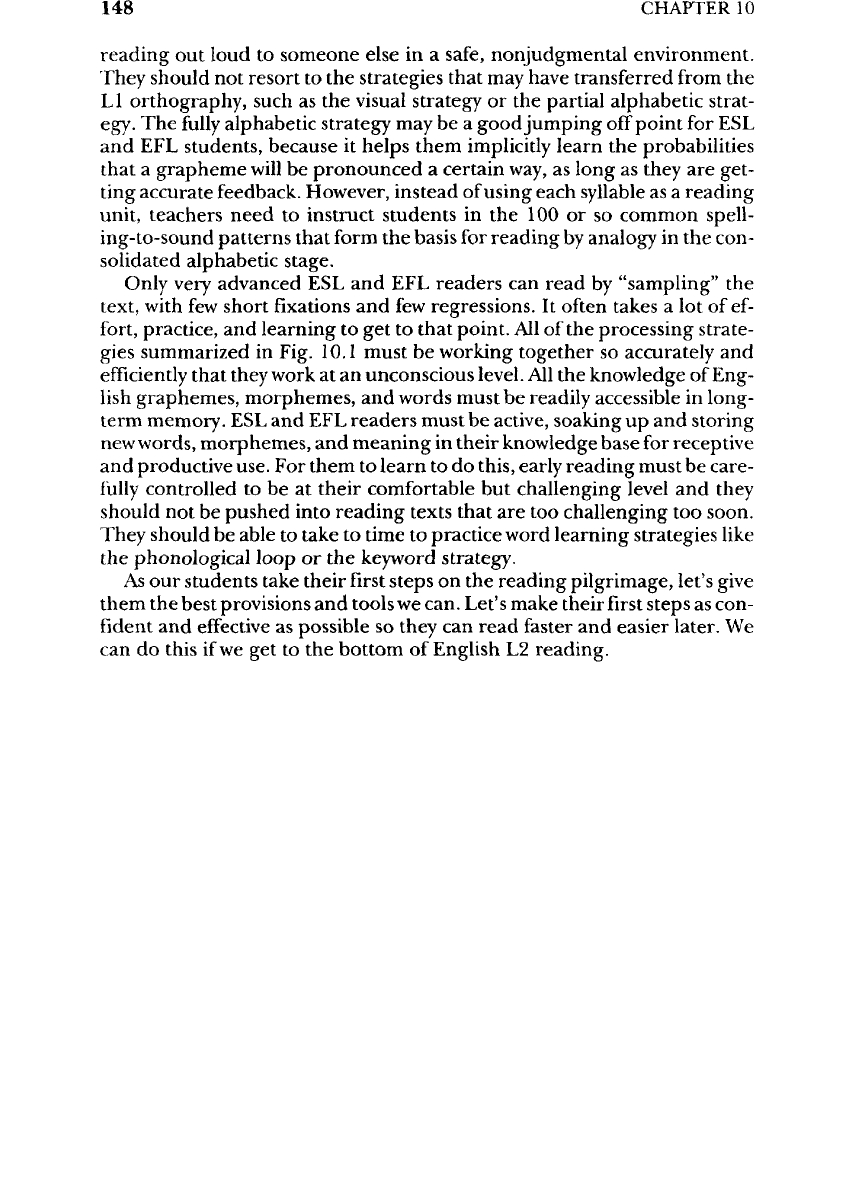
148
CHAPTER
10
reading
out
loud
to
someone else
in a
safe,
nonjudgmental environment.
They should
not
resort
to the
strategies that
may
have transferred
from
the
LI
orthography, such
as the
visual strategy
or the
partial alphabetic strat-
egy.
The
fully
alphabetic strategy
may be a
good jumping
off
point
for ESL
and EFL
students, because
it
helps them
implicitly
learn
the
probabilities
that
a
grapheme
will
be
pronounced
a
certain way,
as
long
as
they
are
get-
ting
accurate feedback. However, instead
of
using each syllable
as a
reading
unit, teachers need
to
instruct students
in the 100 or so
common spell-
ing-to-sound patterns that form
the
basis
for
reading
by
analogy
in the
con-
solidated alphabetic stage.
Only
very advanced
ESL and EFL
readers
can
read
by
"sampling"
the
text,
with
few
short fixations
and few
regressions.
It
often takes
a lot of ef-
fort,
practice,
and
learning
to get to
that point.
All of the
processing strate-
gies summarized
in
Fig.
10.1
must
be
working together
so
accurately
and
efficiently
that they work
at an
unconscious level.
All the
knowledge
of
Eng-
lish
graphemes, morphemes,
and
words
must
be
readily accessible
in
long-
term
memory.
ESL and EFL
readers
must
be
active, soaking
up and
storing
new
words, morphemes,
and
meaning
in
their
knowledge
base
for
receptive
and
productive use.
For
them
to
learn
to do
this, early reading must
be
care-
fully
controlled
to be at
their comfortable
but
challenging level
and
they
should
not be
pushed into reading texts that
are too
challenging
too
soon.
They should
be
able
to
take
to
time
to
practice word learning strategies like
the
phonological
loop
or the
keyword strategy.
As
our
students take their
first
steps
on the
reading pilgrimage, let's give
them
the
best provisions
and
tools
we
can. Let's make their
first
steps
as
con-
fident and
effective
as
possible
so
they
can
read
faster
and
easier later.
We
can
do
this
if we get to the
bottom
of
English
L2
reading.
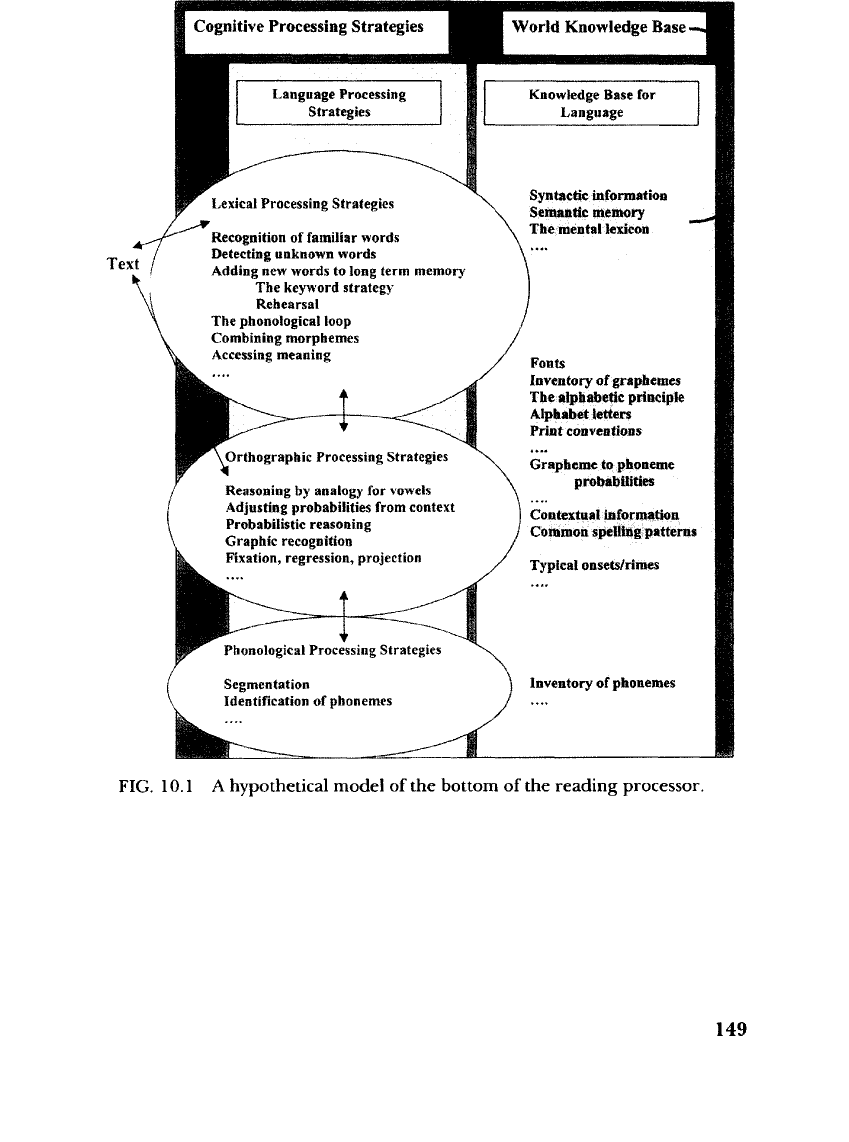
Text
Cognitive
Processing
Strategies
World
Knowledge
Base
Language Processing
Strategies
Knowledge Base
for
Language
Syntactic
information
Semantic
memory
The
mental
lexicon
Lexical
Processing
Strategies
Recognition
of
familiar words
Detecting unknown words
Adding
new
words
to
long
term
memory
The
keyword strategy
Rehearsal
The
phonological loop
Combining morphemes
Accessing meaning
Fonts
Inventory
of
graphemes
The
alphabetic
principle
Alphabet
letters
Print
conventions
Orthographic
Processing Strategies
Grapheme
to
phoneme
probabilities
Reasoning
by
analogy
for
vowels
Adjusting probabilities from context
Probabilistic
reasoning
Graphic recognition
Fixation,
regression, projection
Contextual
information
Common
spelling
pattern
Typical
onsets/rimes
Phonological Processing Strategies
Inventory
of
phonemes
Segmentation
Identification
of
phonemes
FIG.
10.1
A
hypothetical model
of the
bottom
of the
reading
processor.
149

This page intentionally left blank
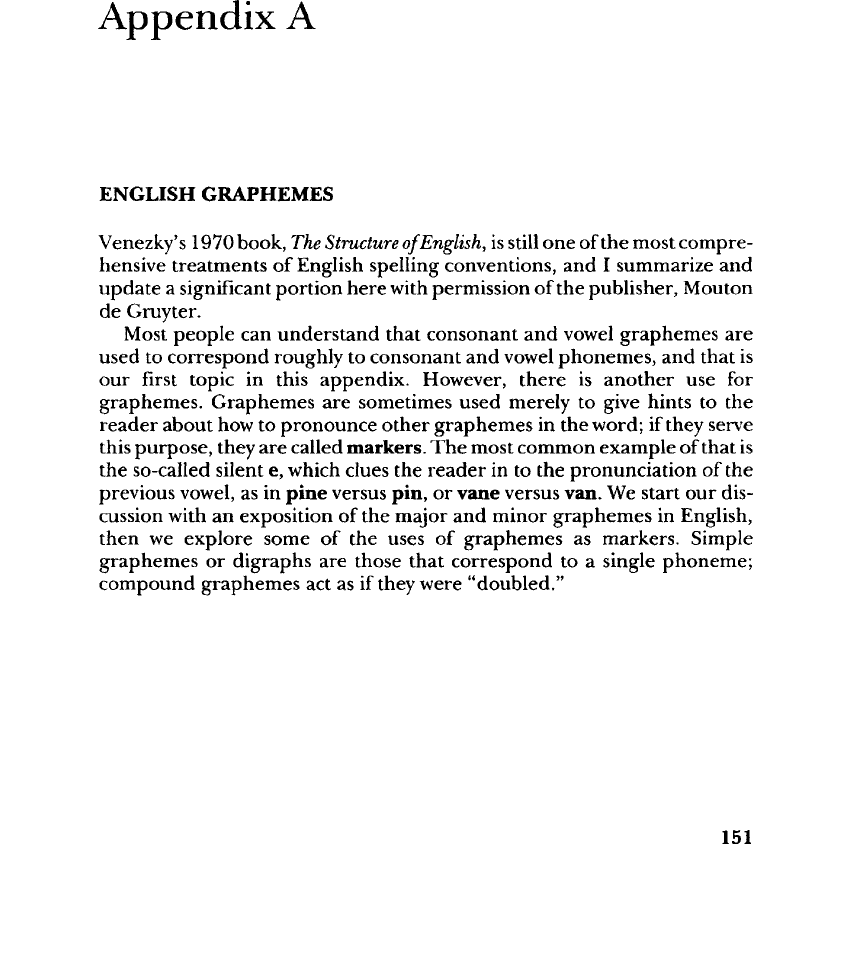
Appendix
A
ENGLISH
GRAPHEMES
Venezky's
1970
book,
The
Structure
of
English,
is
still
one of the
most compre-
hensive
treatments
of
English spelling conventions,
and I
summarize
and
update
a
significant
portion here
with
permission
of the
publisher, Mouton
de
Gruyter.
Most
people
can
understand that consonant
and
vowel
graphemes
are
used
to
correspond roughly
to
consonant
and
vowel
phonemes,
and
that
is
our
first
topic
in
this appendix. However, there
is
another
use for
graphemes. Graphemes
are
sometimes used merely
to
give hints
to the
reader about
how to
pronounce other graphemes
in the
word;
if
they serve
this
purpose, they
are
called
markers.
The
most common example
of
that
is
the
so-called silent
e,
which clues
the
reader
in to the
pronunciation
of the
previous
vowel,
as in
pine
versus pin,
or
vane versus van.
We
start
our
dis-
cussion
with
an
exposition
of the
major
and
minor graphemes
in
English,
then
we
explore some
of the
uses
of
graphemes
as
markers. Simple
graphemes
or
digraphs
are
those that correspond
to a
single phoneme;
compound graphemes
act as if
they were "doubled."
151

152
APPENDIX
A
The
Consonant
Grapheme
to
Phoneme
Correspondences
Consonant
simple
b
g
c
gh
ch
h
d
J
f
k
Notes:
a.
b.
c.
d.
e.
Graphemes
compound
kh q t wh ck
1
r th y dg
m
s u z tch
n sh v x
p sch
w
geminated consonants
u is a
consonant unit when
it
corresponds
to
/w/,
as in
quack
or
language.
wh is
mainly
used
as a
simple consonant corresponding
to
the
voiced
/w/
or the
voiceless
/M/.
In
some dialects,
wh
seems
to
have
a
compound usage /hw/
as in the
"voice-
less"
pronunciations
of the
beginning consonants
of
what,
which,
and
when.
sch is a
simple consonant grapheme when
it is
used
as in
schist
or
schwa.
gn is a
simple consonant grapheme when
it is
used
as in
gnome, cognac,
or
poignant
Geminated consonants
are
compound consonants which
are
simple consonants
doubled:
bb, dd, ff, gg, 11, mm,
nn,
pp, rr, tt, zz, ck, dg, and
tch,
as in
ebb, eddy,
gaffer,
egg,
fell,
dimmer, dinner,
apple,
purr,
better, buzz, back,
edge,
and
watch.
b b in
debt, doubt, subtle
=
/Of.
final
b in
bomb, comb, tomb, crumb
=
/O/.
b
and bb
elsewhere
=
/b/.
Note:
1.
/O/
means that
the
grapheme
is not
pronounced.
2.
When there
are two
bilabial consonants
in the
middle
of
a
word, only
the
second
is
pronounced:
cupboard, sub-
poena,
clapboard,
raspberry.
3.
Note these
nonproductive
alternations. Nonproductive
means that people
do not
make
up new
words
following
this
pattern:
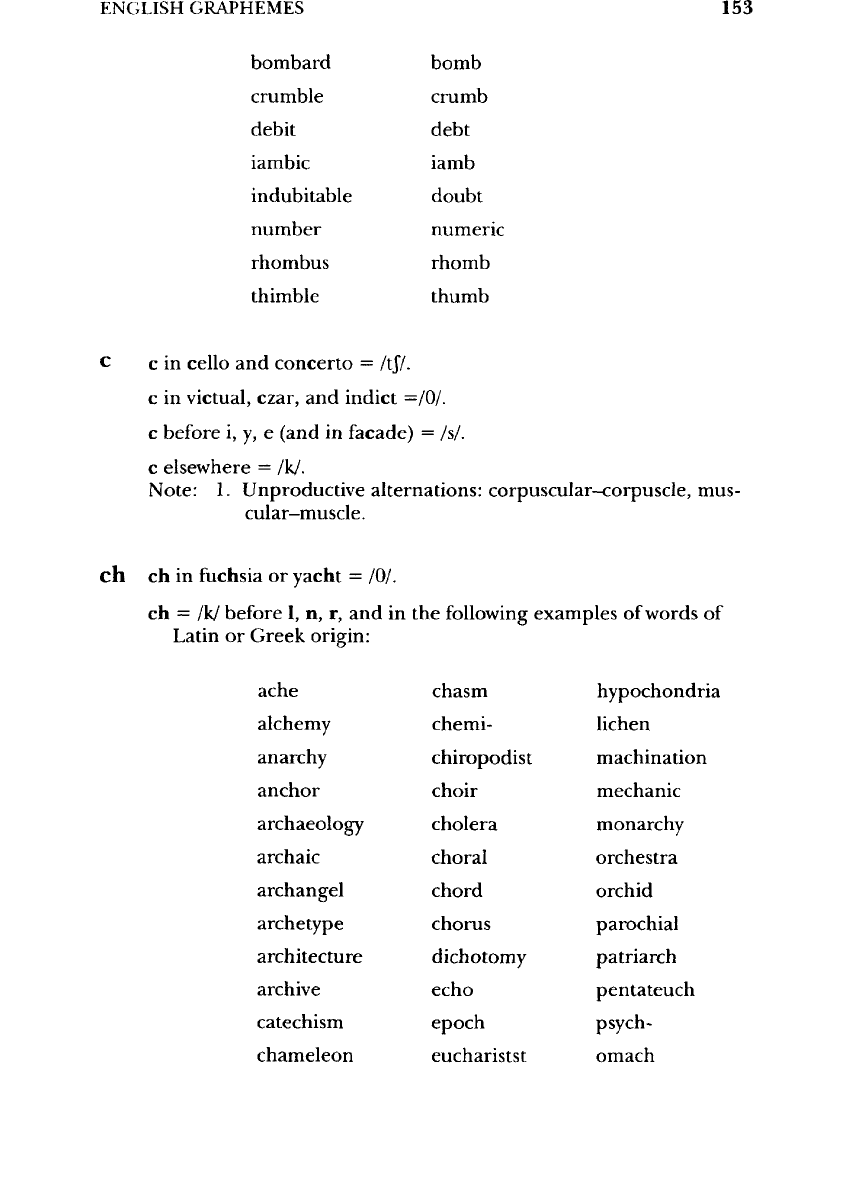
ENGLISH
GRAPHEMES
153
bombard bomb
crumble crumb
debit debt
iambic
iamb
indubitable
doubt
number numeric
rhombus rhomb
thimble
thumb
C
c in
cello
and
concerto
=
/tj7.
c in
victual, czar,
and
indict
=/0/.
c
before
i, y, e
(and
in
facade)
=
/s/.
c
elsewhere
=
/k/.
Note:
1.
Unproductive alternations:
corpuscular-corpuscle,
mus-
cular-muscle.
ch ch in
fuchsia
or
yacht
=
/O/.
ch =
/k/
before
1, n, r, and in the
following examples
of
words
of
Latin
or
Greek origin:
ache
alchemy
anarchy
anchor
archaeology
archaic
archangel
archetype
architecture
archive
catechism
chameleon
chasm
chemi-
chiropodist
choir
cholera
choral
chord
chorus
dichotomy
echo
epoch
eucharistst
hypochondria
lichen
machination
mechanic
monarchy
orchestra
orchid
parochial
patriarch
pentateuch
psych-
omach
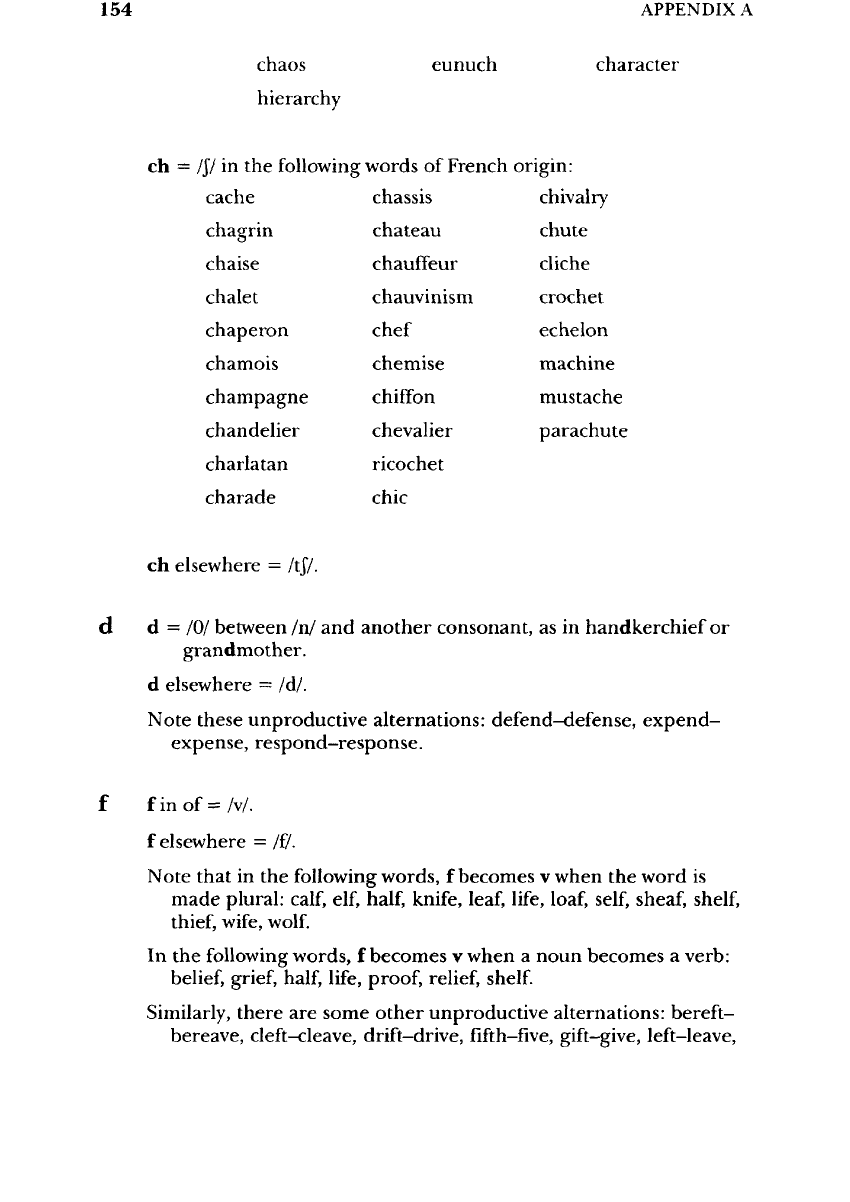
154
APPENDIX
A
chaos
eunuch character
hierarchy
ch =
/J/
in the
following
words
of
French origin:
cache
chagrin
chaise
chalet
chaperon
chamois
champagne
chandelier
charlatan
charade
chassis
chateau
chauffeur
chauvinism
chef
chemise
chiffon
chevalier
ricochet
chic
chivalry
chute
cliche
crochet
echelon
machine
mustache
parachute
ch
elsewhere
=
/tj7.
d =
/O/
between
/n/
and
another
consonant,
as in
handkerchief
or
grandmother.
d
elsewhere
=
/d/.
Note
these unproductive alternations:
defend-defense,
expend-
expense,
respond-response.
f in of
=
/v/.
f
elsewhere
=
/f/.
Note
that
in the
following words,
f
becomes
v
when
the
word
is
made plural:
calf,
elf,
half,
knife,
leaf,
life,
loaf,
self,
sheaf,
shelf,
thief,
wife,
wolf.
In the
following
words,
f
becomes
v
when
a
noun becomes
a
verb:
belief,
grief,
half,
life,
proof, relief, shelf.
Similarly,
there
are
some
other
unproductive alternations:
bereft-
bereave,
cleft-cleave,
drift-drive,
fifth-five,
gift-give, left-leave,
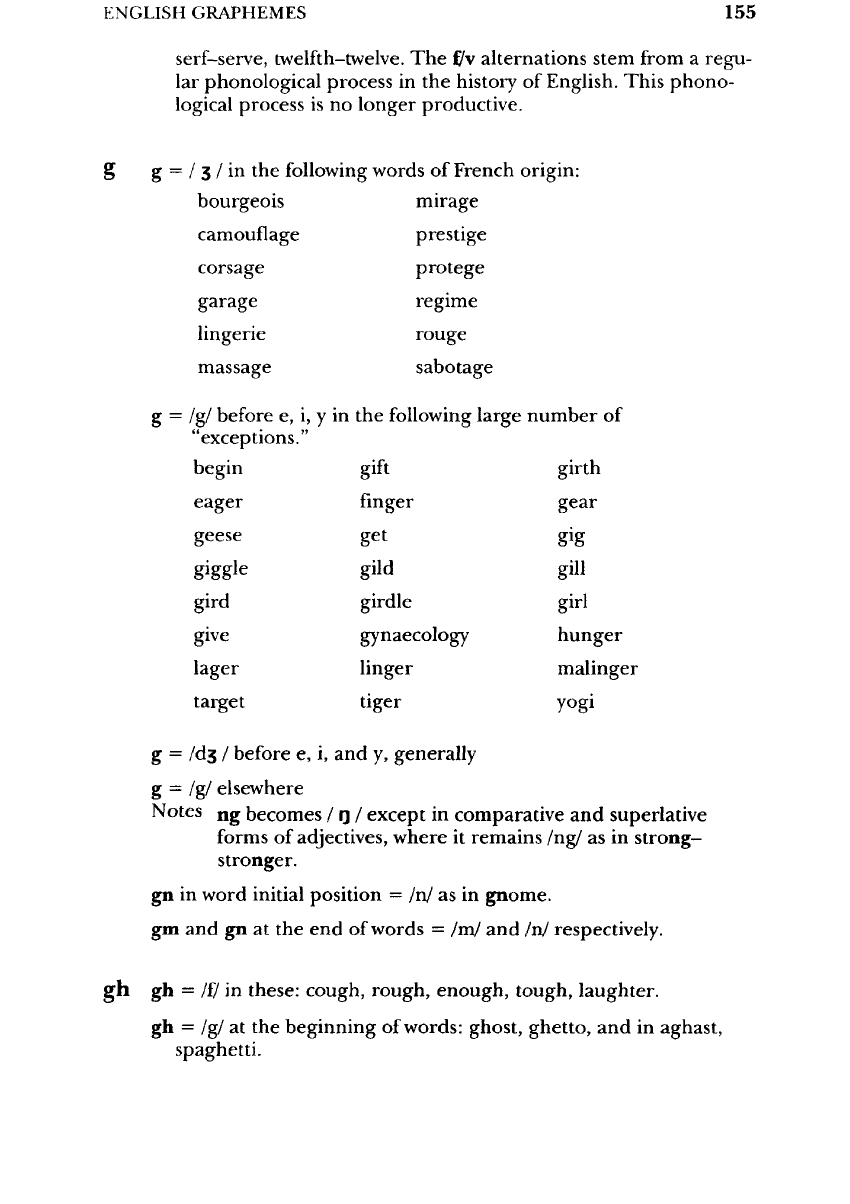
ENGLISH
GRAPHEMES
155
serf-serve,
twelfth-twelve.
The
f/v
alternations stem
from
a
regu-
lar
phonological process
in the
history
of
English. This phono-
logical
process
is no
longer productive.
S g
—
/ 3 / in the
following
words
of
French origin:
bourgeois mirage
camouflage
prestige
corsage
protege
garage regime
lingerie
rouge
massage
sabotage
g =
/g/
before
e, i, y in the
following
large number
of
"exceptions."
begin
eager
geese
gift
finger
get
gild
girdle
gynaecology
linger
tiger
girth
gear
gig
gill
girl
hunger
malinger
yogi
gird
give
lager
target
g =
/d3
/
before
e, i, and y,
generally
g =
/g/
elsewhere
Notes
n
g
becomes
/
Q
/
except
in
comparative
and
superlative
forms
of
adjectives, where
it
remains
/ng/
as in
strong-
stronger.
gn in
word initial position
=
/n/
as in
gnome.
gm
and gn at the end of
words
=
/m/
and
/n/
respectively.
gh gh
=
/{/
in
these: cough,
rough,
enough, tough, laughter.
gh =
/g/
at the
beginning
of
words: ghost, ghetto,
and in
aghast,
spaghetti.

156
APPENDIX
A
gh
elsewhere
=
/O/.
h h =
/O/
in
heir,
honor,
herb, hour, vehicle,
and
other
words
of
French origin.
h =
/O/
preceded
by a
consonant: philharmonic.
h =
/h/
elsewhere.
J j
=
/
dj/
except
in
words borrowed
from
Spanish:
Juan,
marijuana.
k k =
/k/.
Note:
in
kn,
k =
/O/
except
in
acknowledge,
possible because
of
the c.
Nonproductive alternations:
speak-speech,
leak-leach,
wreak-wretch, wicca-witch.
1 1 in the
word colonel
=
/r/.
1
in
would, could, should,
half,
calm, chalk
=
/O/.
1
otherwise
=
/!/.
Note:
1
occurs
in
many consonant clusters:
pi,
bl,
cl,
chl,
gl,
fl,
si,
spl
at the
beginning
of
words;
Ip,
It,
Id,
Ik,
Ich,
1m,
rl,
rid,
Ib
at the
ending
of
words.
le
at the end of
words
is
syllabic
(is
pronounced like
a
syllable
/
a
I/)
as
in
simple, kettle,
and
nettle.
m
m =
/m/.
Note:
the
initial cluster
mn = /n/
mnemonic.
n
n =
/n/.
Note:
n
before
k and g
becomes
/
Q
/.
p p
=
/O/
in
corps, coup,
and
receipt
and the
first
p in
sapphire.
p in
clusters
pn, ps, and pt =
/O/,
as in
pneumonia, psychology,
and
ptomaine.
p
elsewhere
=
/p/.

ENGLISH GRAPHEMES
157
ph ph
=
/f/.
q q =
/k/
and
always
appears before
u.
r r =
/r/.
Note:
r
occurs
in
many clusters:
br,
chr,
cr, dr, fr, gr,
phr,
pr,
scr,
shr, spr, str, thr,
wr at the
beginning
of
words;
and rb, rp,
rd, rt, rg,
rf,
rth,
rsh, rch,
rm,
rn,
rl,
rpt, rst,
rid
at the end
of
words,
r in the
sequence
er
becomes
a
syllabic
r as in
but-
ter,
better,
and
baker.
rh rh =
/r/,
as in
rhino, cirrhosis.
s s = /s/ at the
beginning
of
words
and at the end of
words,
generally,
s
=
/s/
in the
middle
of a
word before
or
after
a
voiceless
consonant,
s
=
/z/
after
a
voiced consonant
and in as,
has, his,
is, and
was.
s =
/z/
elsewhere,
as in
design, dissolve;
the
verbs: house, use,
and
close.
Note:
s
occurs
in
many clusters:
ps, sc,
sch,
schw,
scl,
scr,
sk,
si,
sm,
sn, sp,
sph,
spl,
spr, squ,
st,
str,
sv,
sw
at the
beginning
of
words;
and sp, st, sk, rst at the end of
words.
Note:
s =
/O/
in
aisle, corps, island, isle,
bourgeois,
chamois, Illi-
nois, debris,
and
rendezvous. Some
of
these words have
an s
inserted
in the
spelling
for no
good
reason
and
some
are of
French origin.
sh sh =
/J7.
t t =
/O/
in
some clusters
as in
listen, often,
soften,
and
castle.
t =
/t/
elsewhere except when palatalized
in
derivational
morphology.
t =
/O/
in
depot, debut,
and
mortgage,
and in
words ending
in et
with
the
accent
on the
final
syllable: valet,
buffet,
and
ballet.
These
words
are of
French origin.
Note:
t
occurs
in
many clusters:
pt, st,
str,
tr,
tw
at the
beginning
of
words;
and ct, ft,
ght,
It,
mpt,
net,
nt, pt,
rpt, rst,
rt, st,
tz,
xt at the
ending
of
words.
